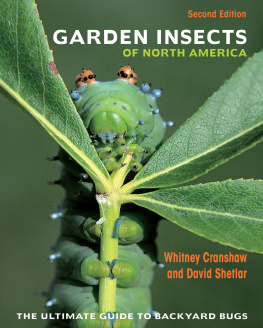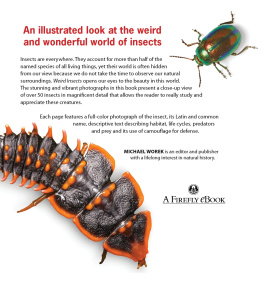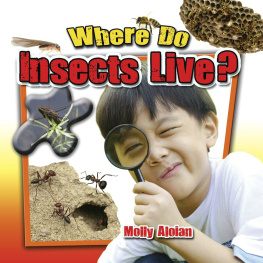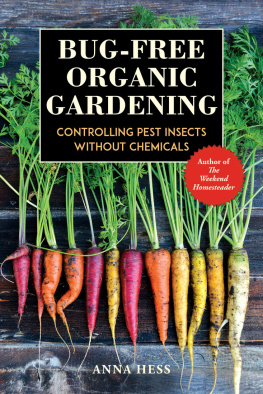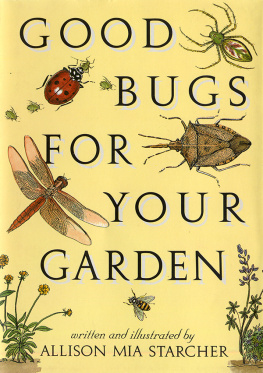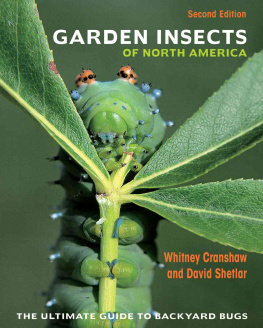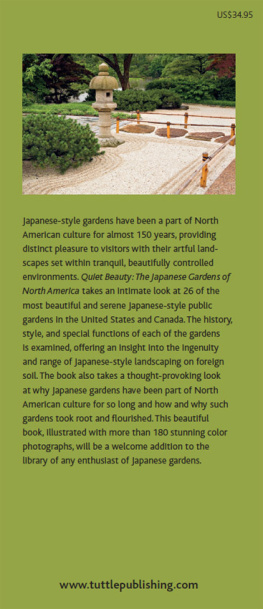Cranshaw - Garden Insects of North America
Here you can read online Cranshaw - Garden Insects of North America full text of the book (entire story) in english for free. Download pdf and epub, get meaning, cover and reviews about this ebook. year: 2017, publisher: Princeton University Press, genre: Romance novel. Description of the work, (preface) as well as reviews are available. Best literature library LitArk.com created for fans of good reading and offers a wide selection of genres:
Romance novel
Science fiction
Adventure
Detective
Science
History
Home and family
Prose
Art
Politics
Computer
Non-fiction
Religion
Business
Children
Humor
Choose a favorite category and find really read worthwhile books. Enjoy immersion in the world of imagination, feel the emotions of the characters or learn something new for yourself, make an fascinating discovery.
Garden Insects of North America: summary, description and annotation
We offer to read an annotation, description, summary or preface (depends on what the author of the book "Garden Insects of North America" wrote himself). If you haven't found the necessary information about the book — write in the comments, we will try to find it.
Garden Insects of North America — read online for free the complete book (whole text) full work
Below is the text of the book, divided by pages. System saving the place of the last page read, allows you to conveniently read the book "Garden Insects of North America" online for free, without having to search again every time where you left off. Put a bookmark, and you can go to the page where you finished reading at any time.
Font size:
Interval:
Bookmark:

Second Edition
GARDEN INSECTS
OF NORTH AMERICA
THE ULTIMATE GUIDE TO BACKYARD BUGS
Second Edition
GARDEN INSECTS
OF NORTH AMERICA
THE ULTIMATE GUIDE TO BACKYARD BUGS

Whitney Cranshaw
and David Shetlar
PRINCETON UNIVERSITY PRESS
PRINCETON AND OXFORD
To entomology educators and the Cooperative Extension system that so well foster the spirit of shared learning.
Copyright 2018 by Princeton University Press
Published by Princeton University Press, 41 William Street, Princeton, New Jersey 08540
In the United Kingdom: Princeton University Press, 6 Oxford Street, Woodstock, Oxfordshire OX20 1TR
nathist.princeton.edu
Photographs previous page: left ailanthus moth (Jim Kalisch, University of Nebraska); above, center lizard beetle (Jim Kalisch, University of Nebraska); right bumble bee and a solitary bee (Whitney Cranshaw); below, center shell of a cicada nymph discarded at molting (David Shetlar).
All Rights Reserved
Library of Congress Cataloging-in-Publication Data
Names: Cranshaw, Whitney, author. | Shetlar, David J., author.
Title: Garden insects of North America : the ultimate guide to backyard bugs / Whitney Cranshaw and David Shetlar.
Description: Second edition. | Princeton, New Jersey : Princeton University Press, 2017. | Includes bibliographical references and index.
Identifiers: LCCN 2017013286 | ISBN 9780691167442 (pbk. : alk. paper)
Subjects: LCSH: Garden pestsNorth AmericaIdentification.
Classification: LCC SB605.N7 C73 2017 | DDC 635/.0496--dc23 LC record available at https://lccn.loc.gov/2017013286
British Library Cataloging-in-Publication Data is available
This book has been composed in Minion Pro (text) and Guess Sans (headings)
Printed on acid-free paper.
Typeset and designed by D & N Publishing, Wiltshire, UK
Printed in China
10 9 8 7 6 5 4 3 2 1
CONTENTS
PREFACE
Well over 100,000 species of insects and other arthropods are known to exist in North America, and the scope of this book is necessarily limited. Emphasis herein is on those garden bugs that are most likely to be encountered in a yard and garden, particularly those that injure plants. Selecting which insects, mites, and other garden bugs to includeand perhaps more importantly which not to includehas involved many judgment calls. For example, many insects restricted primarily to forests, grasslands, waters, or other natural areas overlap in their presence and activity in yard and garden settings.
In this second edition of Garden Insects of North America a great many changes have been made. Perhaps most obvious is the greatly increased number (and quality) of images, reflecting the enormous changes that have occurred with photography of insects since 2004. But the number of species included in this edition has also greatly expanded. This expansion has occurred throughout the book, but some sections are either completely new or have been given greatly expanded treatment. This new treatment is particularly evident in , which discusses natural enemies of insects and mites along with important pollinator species of bees.
The expanded treatments in this second edition have been made possible by making this a coauthored publication, involving the complementary experiences of both Whitney Cranshaw and David Shetlar.
ORGANIZATION
Garden Insects of North America is designed to provide a means to identify the types of insects one might find in a yard and garden and to diagnose their presence based on associated symptoms they may produce on plants. To best achieve this approach, we adopted an organization that is a hybrid of ways that other books on insect identification are organized. In Garden Insects of North America the primary groupings involve the parts of plants where one might most often notice insects. For examples, has a different focus, covering the natural enemies of insects and one group of important flower-visiting pollinators, the bees.
Within these main chapters, the associated insects (and other garden bugs) are usually organized by taxa, to the genus level whenever appropriate; however, we have made an effort to place insects together in the text that have somewhat similar appearance or habit. For example, mealybugs are placed near related groups such as woolly aphids and soft scales. Also, the caterpillars of many families of moths and skippers form protective shelters of silk, frass, or leaf fragments, or combinations of these, and these are grouped. At the end of each section, classification to the order and family level is noted. For example, following discussion of the peach tree borer there is the notation Lepidoptera: Sesiidae to indicate that the peach tree borer is in the order Lepidoptera (moths and butterflies) and the family Sesiidae (clearwing borers).
The diversity of insect habits clearly defies easy grouping. For example, western corn rootworm develops as a root-feeding larva on corn plants, then feeds on leaves and flowers of a wide variety of plants as an adult. Japanese beetle is a first-class problem in turfgrass, where it develops underground as a white grub, but later as an adult that feeds on leaves and flowers of many garden plants. Such crossover species are treated primarily in one section (western corn rootworm as an insect that develops on plant roots, Japanese beetle as an insect that chews on leaves), but where such insects occur there are cross-references and treatments in other chapters.
COMMON NAMES
Throughout the book we often use common names, concurrently defined with a scientific name (genus, species). When we decided to use a common name, we always gave precedence to names accepted by the Entomological Society of America, which has a long-established procedure for formalizing common names of insects. For many insects and their relatives, however, there are not yet any officially recognized common name. Where this occurs, often one or more names have been proposed in other publications. Some of these are used in this book. Ultimately all such common names should be formally proposed and, where acceptable, recognized by the Entomological Society of America and Entomological Society of Canada.
ACKNOWLEDGMENTS
This second edition of Garden Insects of North America builds on the original 2004 edition. At that time we acknowledged dozens of colleagues and resources who allowed this project to begin, and their contributions continue to be carried forward in this edition.
A wide variety of individuals and organizations have also been involved in the changes reflected in this revision, and some of them need special acknowledgment. In the past 13 years there have been wonderful improvements in both quality and accessibility of fact sheets and research reports provided by state programs associated with Cooperative Extension, state IPM programs, and the USDA Forest Service; these have been extensively reviewed in the development of this project. In addition, a new resource that has been exceptionally useful is BugGuide.Net, hosted at Iowa State University and currently maintained by John VanDyk. This website offers an enormous number of arthropod images and is well curated through the contributions of entomology specialists throughout the continent. Along with the multiple images it provided to illustrate features of almost every species included in this book, the details on insect distribution and classification were particularly valuable.
Next pageFont size:
Interval:
Bookmark:
Similar books «Garden Insects of North America»
Look at similar books to Garden Insects of North America. We have selected literature similar in name and meaning in the hope of providing readers with more options to find new, interesting, not yet read works.
Discussion, reviews of the book Garden Insects of North America and just readers' own opinions. Leave your comments, write what you think about the work, its meaning or the main characters. Specify what exactly you liked and what you didn't like, and why you think so.

